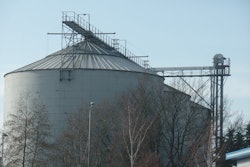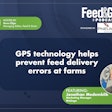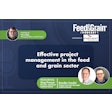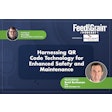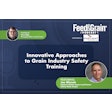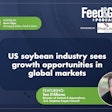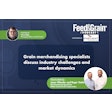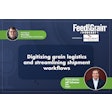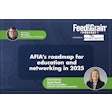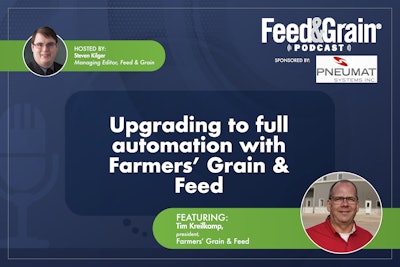
Join Steven Kilger, the host of the Feed & Grain Podcast, as he takes you on a captivating journey alongside Tim Kreilkamp, president, and Glenn Schellinger, mill manager of Farmers’ Grain & Feed. Discover the transformative story of building a new feed mill in Allenton, Wisconsin, and the profound impact it has on the community, employee loyalty, and overall efficiency. From the secrets of staff buy-in to the groundbreaking integration of technology, explore the insights and "whoa" moments that come from opening a new feed mill.
Podcast Sponsored by Pneumat Systems.
Transcript has been edited for clarity.
Steven Kilger (0:00):
Hi everyone, my name is Steven Kilger. I'm the managing editor for Feed & Grain Magazine and the host of the Feed & Grain Podcast. Thank you so much for joining me today as we dive deep into the issues affecting feed manufacturing, grain handling and allied industries.
Kilger (0:14):
Today's episode is brought to you by the BinWhip from Pneumat Systems. The powerful Dual Impact BinWhip removes the toughest buildup and blockages in industrial storage silos - without hazardous silo entry. Learn more today at binwhip.com.
Kilger (0:31):
Today's episode is a throwback, with Tim Kreilkamp, president of Farmers’ Grain & Feed, and Glenn Schellinger the mill manager, talking about their feed mill in Allenton, Wisconsin, this interview was actually turned into a cover story. But that just means that I had to cut out about 95% of what we actually talked about. In this interview, we talk about the building of a new feed mill versus the renovating of an old one, what a project like this means to the community, employee loyalty and of course, some just general facts about their new feed mill. This was recorded in a working feed mill. So please forgive the amount of background noise you might hear during the interview.
Kilger (1:07):
I really hope you enjoy it. And if you want to help out the podcast and are listening to this in a podcasting app, please rate us and please rate us and subscribe. If you're listening online, sign up for the Feed & Grain newsletter Industry Watch to see when the latest podcasts are posted, and stay up to date with all the latest news from around the industry. Now on to the show.
Kilger (1:26):
Thank you guys so much for taking the time to talk to us today. We're really happy to be here. So why don't we start at the beginning? When did you guys decide that a new mill might be in your future?
Tim Kreilkamp (1:39):
We bring in different people with different backgrounds to become an advisor suite for each company, we have four different companies on the back of there. So if we go through each one financials are part of it. But the other part is what are you doing? How do we make it better? What did you think about what didn't you think about all that? So moving on from that challenge us with more. How do we increase this? How do we do that? So what we've agreed to is at the time, we need to build out.
Kreilkamp (2:02):
So we need manufacturing operating separately from logistics because what happens today is manufacturing, I'll have a Batch Mixer, and it has to go right into a truck. So we have to have a truck sitting there below that. Well, if the truck isn't back, then you stop manufacturing. Glenn had a lot of great ideas. Let's get rid of the augurs, and put load-out bins there. Let's put them over here. We're on a postage-size lot there, we have the lumberyard, we have the railroad, we have two roads. We were just done. The corporation on this land already we can. There are grain bins out there, we had three bins and a dryer out there ready. So we thought okay, why don't we make this or center for the feed mill? And we started out with, "Well, we'll do it small. And we'll just do some of the production up here. And we'll do some down there." We get further in the planning and ahh - it doesn't make sense. Well, why don't we move it all up? Oh, why don't we just get a bigger mixture? And we can do everything? Well, why don't we just add this on and this is what we ended up with. Just kept, let's put that let's put that now here we are.
Kreilkamp (2:55):
So we felt it was the best thing to put all the manufacturing in one spot and make this as efficient as possible. And the accuracy with all these processes that are in place with Repete, it's just unbelievable. So one stupid thing, I'm getting off on a tangent here, but when there's a product in the bin, those augers we'll start out delivering to the scales, as soon as they get close to the target, they'll slow down. So if that auger is talking to the scale, and it's supposed to be that way, if it's not, it's self-correcting continuously, so that software makes itself smarter, the more you use it the smarter it gets. So the quality of this feed is going to be so much higher, there's no way we could have a good quality program at our old mill.
Glenn Schellinger (3:32):
You can't comply with the standards. When you have so much hand activity going on. How do you catch the data points? You can't?
Kreilkamp (3:38):
You can't. Here you're catching everyone. Are you familiar with Power BI? So it's a Microsoft product, so it kind of measures you and it goes out to different systems and holds it all together. And it displays it in a graph on the player however you want to see it. But that's what we're gonna have, a bunch of dashboards out here because we have so many data points. If the information is captured, we can follow it and use it to measure ourselves.
Kilger (4:01):
Yeah, data collection, I think is the next big growth area in the industry overall. So it's, great that you guys are taking advantage of that.
Kreilkamp (4:09):
So we're hoping well, not hoping we will, if you give us about a year we'll have we'll have a whole bunch of dashboards that will be able to tell you how much gluten we use and what the trend is. It makes us smarter when we buy. In July we find out once we get some data there. It's like well, July we should never buy this type of product. Because it's always bad. You know, maybe we'll learn something like that.
Kilger (4:30):
They're cool. Can you give me the history kind of Farmers’ Grain & Feed?
Kreilkamp (4:33):
A little history, the Hess family started the co-op in 1913. I don't know if I have the years memorized. There there. I just don't have them in my head.
Kilger (4:43):
I'll be sending you a copy so you can always double-check.
Kreilkamp (4:46):
So then Grandpa or Dad Hess got hit by the train in Ellington. So that son took over and he was in his early 30s.
Kilger (4:53):
I'm sorry, you brush past he got hit by a train?
Kreilkamp (4:57):
Yes, I don't know what he was doing but he did get hit. Then Kathy was the next one. So it was a co-op the entire time. So there were different managers, but they had a majority stock share of it. Before we bought, there were two people, Dave Schellinger distant relationship, and Terry. And they ran the place for probably 30 years. And then they wanted out, they were at retirement age, and my dad sat on the board of directors with them. And he says, you know, when you should buy that, you know diversify us. Because we had a trucking and warehouse company at the time, we should do that. Long story short, we ended up with it and here we are today. We're very, very happy from 2006 that we did jump in and do that. So a little history there. So WB Holdings has all those companies underneath it. So it started out with trucking. So my great-grandfather started trucking in 1935 in Allenton. Okay, right off the hill from the old feedmill, a couple blocks up the hill. He passed it off to his son, who would be my grandpa in 1947. My dad bought it in '65. And then my brother and sister and myself bought it in '93.
Kilger (6:03):
So it's four generations. You said it was 2006, you guys got into the feed game.
Kreilkamp (6:08):
Yeah, feed and implement. It was Farmers Incorporated. So we split it out, in that the implements were on their own, and Grain & Feed was on its own.
Kilger (6:15):
So how many locations? Do you guys have that in total? What kind of falls under your umbrella?
Kreilkamp (6:20):
Total? Oh, goodness. 23.
Kilger (6:24):
So you're pretty big in this area, then a pretty big employer?
Kreilkamp (6:27):
We have 550 employees in total.
Kilger (6:30):
So Wow. Yeah, that's a lot.
Kreilkamp (6:31):
And that includes California and New Jersey, Milwaukee. Well, we have a warehouse company, WB Warehouse. So that has two locations California and New Jersey.
Kilger (6:42):
Okay. And is this your only feed mill?
Kreilkamp (6:46):
This is the only one.
Kilger (6:46):
So can you guys tell me about the process a little bit? So once your grain or ingredient, your ingredients are dropped off, how do they kind of move through the mill and eventually make your final products?
Schellinger (7:00):
They're received into major, the major bin cluster. Orders are taken, formulas are made and pushed into the automation system. When the producer or production guy wants to make that formula, he calls it up and initiates it. Sends it to the scales, scales it, which pulls it out of bins, blends it, and puts it over to a loadout bin.
Kilger (7:36):
So you see you guys are able to make feed almost on demand then, depending on what formula they want. Excellent. How long does it take?
Kreilkamp (7:44):
Here's the best way to explain it. And I'll step in here. We had no storage at the old facility. So the best way to handle everything is if it's an emergency. So everything was an emergency, most everything, and we got to get the mind change and say you know what? Let's let's do tomorrow's orders today.
Kilger (8:00):
Yeah. So you said that this mill is four times as efficient as the last one? So how many tons do you guys produce a week?
Kreilkamp (8:11):
We were approximately 150/day. So four times that on the conservative side. We think if everything is right for you to do more than that. But we want to be conservative.
Kilger (8:22):
As we discussed earlier, you're not an integrated producer, you're not just doing four types, or you can just pound it out over and over. How is your customer base, handling this? Are they excited?
Kreilkamp (8:33):
Producers in this area are excited that we took the initiative to invest in their industry. They're excited about their industry. And that's always nice. Are they like it when someone else is just as excited about what they're doing? Yeah, passionate. And certainly, there's a lot of passion here with this team that works here. So there are 22 people, but there's virtually zero turnover. We just don't have people leaving us unless it's retirement, or sickness, or something like that. But other than that people don't leave here. And it's a smaller group. So there's only 24 of them but they are really solid and they're all bought in and that relates to the customer also when they're delivering. Somebody can tell that when somebody bought in and right. When you have a delivery person coming, you know if they're just there to punch a clock or they're there because they really want to be there.
Kilger (9:19):
Would you say is your secret to getting your staff to buy into your mission?
Kreilkamp (9:23):
I would say a big part of it is their leader, Glenn.
Schellinger (9:25):
You've got to participate in it, otherwise, "Why should I?"
Kilger (9:32):
It's a major part. Talk a little bit about the advantages of having a grain elevator on site so that I know the pipes are not quite complete yet. But eventually, you'll be able to pull over your bulk ingredients straight from the bins, right?
Kreilkamp (9:42):
Yeah, so a major portion of the feed is corn so we can move the corn over with a push of the button and not rehandle it again. Pull it from the truck, then pull it over and dump it again, that's a good efficiency.
Schellinger (9:56):
The big push in the dairy industry right now is consistency. Cows like anybody like consistency, so dry corn going to diet, has in the last few years just kind of skyrocketed. And having corn that can be reclaimed to a feed mill, without trucking it, just by starting up some motors. The mill is more efficient and diets are more stable. When you have the variations with corn silage and haylage already, if you can keep the corn steady, that makes the diet that much better. And when you have to truck your corn to the mill at that kind of volume, just like we were saying before you spend hours hauling it.
Kreilkamp (10:34):
Which is all cost. So if you're going to take it off the field, put it someplace where you don't have to rehandle it.
Kilger (10:41):
Yeah, and you guys, you mentioned that you guys own your own fleet. So how far out, do you guys kind of go with your deliveries?
Kreilkamp (10:48):
Well, with the efficiency of this mill, we think we're gonna be able to get further. We know we were limited. We could not take on new customers, we were handcuffed. I mean, we were getting as much out of their thing as you could possibly get. It wasn't enough. So. So the efficiency of this mill will allow us to track it a little bit further. So that cost savings and manufacturing, we can spend that trucking, and still be competitive.
Kilger (11:08):
So were you guys able to put all of your staff from the old mill and keep everyone that's great. Like you said they they like working for you? Well, this is a question I always ask, What's your biggest, "whoa", moment, this is completely changing the game on how we make our feed.
Kreilkamp (11:24):
I think just the efficiency of this, mill. Like the example we used before, it would take 35-40 minutes to make one batch now it's made in 11 minutes or something like that. So that tells you, I mean, we're shrinking that. Getting everything kind of dialed in and figured out. Once we're used to using what we have here, it's going to be very, very, very efficient.
Schellinger (11:43):
The biggest thing wow moment for me was to see the integration between interfacing, batching software, and ERP software, the actual capture of data. This is what we sent you to manufacture. This is what you manufactured. And now bring that back to home base to invoice. That's pretty cool stuff. You see it, finalizing it, it all comes together. So this is going to work. Because we talked to the software development companies, "You guys got to talk to each other, How do you make this work?" You know, when it starts coming, you get a few glitches here and there and you work through them and we will get through them is impressive to see that happen.
Kilger (12:20):
Those are both very good answers. My favorite answer ever got is from someone who's just like "The lights, I love how bright it is in there." I can't think of any more questions I have for you right now.
Kilger (12:33):
Oh, what an abrupt ending. Thank you so much for listening. We actually said our goodbyes off the mic. So I wanted to jump in here and say till next time. Stay safe out there.
.jpg?auto=format%2Ccompress&crop=faces&fit=crop&h=48&q=70&w=48)





